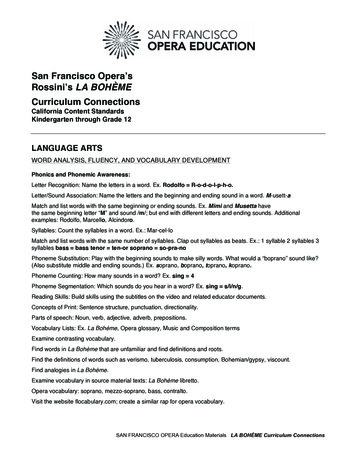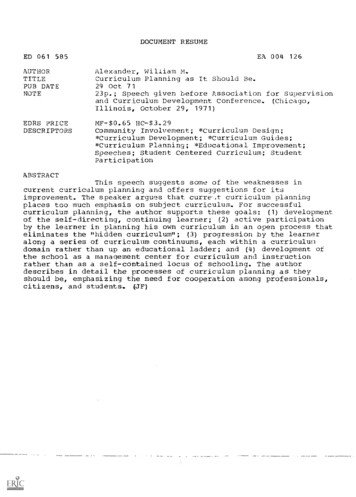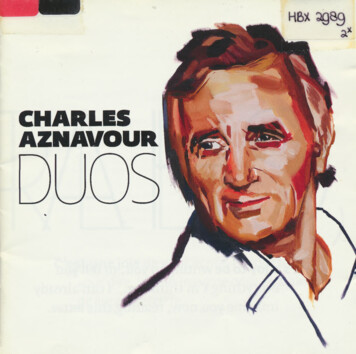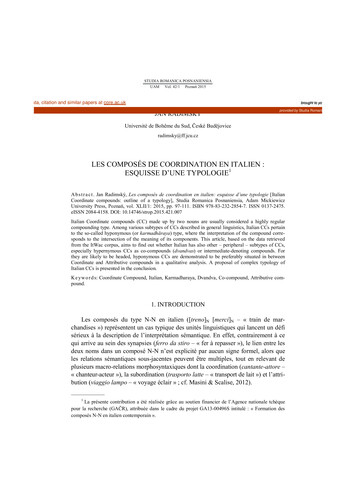
Transcription
San Francisco OperaʼsRossiniʼs LA BOHÈMECurriculum ConnectionsCalifornia Content StandardsKindergarten through Grade 12LANGUAGE ARTSWORD ANALYSIS, FLUENCY, AND VOCABULARY DEVELOPMENTPhonics and Phonemic Awareness:Letter Recognition: Name the letters in a word. Ex. Rodolfo R-o-d-o-l-p-h-o.Letter/Sound Association: Name the letters and the beginning and ending sound in a word. M-usett-aMatch and list words with the same beginning or ending sounds. Ex. Mimi and Musetta havethe same beginning letter “M” and sound /m/; but end with different letters and ending sounds. Additionalexamples: Rodolfo, Marcello, Alcindoro.Syllables: Count the syllables in a word. Ex.: Mar-cel-loMatch and list words with the same number of syllables. Clap out syllables as beats. Ex.: 1 syllable 2 syllables 3syllables bass bass tenor ten-or soprano so-pra-noPhoneme Substitution: Play with the beginning sounds to make silly words. What would a “boprano” sound like?(Also substitute middle and ending sounds.) Ex. soprano, boprano, toprano, koprano.Phoneme Counting: How many sounds in a word? Ex. sing 4Phoneme Segmentation: Which sounds do you hear in a word? Ex. sing s/i/n/g.Reading Skills: Build skills using the subtitles on the video and related educator documents.Concepts of Print: Sentence structure, punctuation, directionality.Parts of speech: Noun, verb, adjective, adverb, prepositions.Vocabulary Lists: Ex. La Bohème, Opera glossary, Music and Composition termsExamine contrasting vocabulary.Find words in La Bohème that are unfamiliar and find definitions and roots.Find the definitions of words such as verismo, tuberculosis, consumption, Bohemian/gypsy, viscount.Find analogies in La Bohème.Examine vocabulary in source material texts: La Bohème libretto.Opera vocabulary: soprano, mezzo-soprano, bass, contralto.Visit the website flocabulary.com; create a similar rap for opera vocabulary.SAN FRANCISCO OPERA Education Materials LA BOHÈME Curriculum Connections
Symbolism/Metaphors: Candle, Flame (burning bright, flickering, extinguished), Moon, Key, Shoes, Blanket, MuffHow do metaphors work? What are some other metaphors in the opera?Nickname/alias – In the aria “Che gelida manina,” Mimi reveals that her real name is Lucia.Reading Comprehension:Story Development (Whatʼs the beginning, middle and end?): Character desires and motivation; Cause andeffect: What made this happen?The sequencing of events, climax, and resolution.Watch different versions of the opera on DVD; how do they differ and why?Reflect on your viewing of the opera by sharing your questions about it with the other students.Read:Opera source material: Source material for La Bohème, La Bohème libretto, letter from Puccini, biographies, etc.Types of text: Poetry, fairy tale, song text, libretto, script for media arts, biography, etc.Creative writing:Interpret the story and create a new version. Create your own characters or change the operaʼs time period andsetting. Ex. Rodolfo blogger. Create your own characters that are missing from the opera.Explore different genres of writing: poetry, song text, libretto, script for media arts, biography, autobiography, shortstory, historical novel, etc.Explore literary devices such as the use of point of view, internal/external conflict, repetition of phrases andforeshadowing.CREATIVE WRITINGReinterpret the story by creating a new version using your own characters, time period and setting.Explore different genres of writing: poetry, song text, libretto, script for media arts, biography, autobiography, shortstory, historical novel, etc.Explore literary devices such as the use of point of view, internal/external conflict, repetition of phrases andforeshadowing.Analysis and Interpretation: Expository writing, critiques/reviews.Persuasive Writing: Letter writing, copywriting: advertising, fundraising, press release.Persuasive writing: create posters, advertisements for one of the characters.Write about what you would do in Mimiʼs place, or in Musettaʼs place.Write about what would happen to the characters if the story continued.Set the story in a different time and place. Update the dialogue.Pretend youʼre Rodolfo – write a journal/diary entry while living with Marcello, Colline and Schaunard, right aftermeeting Mimi for the first time.Pretend youʼre Mimi – Write a letter to Rodolfo after he has treated you poorly.How would you create a change of mood from comedy to tragedy? (ex.: In Act III, the men are playing around,when Mimi enters dying)SAN FRANCISCO OPERA Education Materials LA BOHÈME Curriculum Connections
LITERARY RESPONSE AND ANALYSISElements of a Story:Character, plot, setting, conflict.Identify the following in the opera: Inciting incident; Rising action; Climax; Descending actionOutline what happens in Act I, II, IIIVocabulary:Reading for understanding using the subtitles on videos and related educator documents.Genres:The story of La Bohème touches upon many genres: Love Story / Romance, Comedy, TragedyComedy: Farce,slapstick. Trace history of Commedia characters to current day.Where do you see romance, comedy and tragedy in TV shows or films today?The romance genre highlights the relations between men and women.Themes:Love and the complexity of the emotion: Love, Elation, Trust, Anger, Forgiveness, Anguish, SorrowTruth, Beauty, Hope and VirtueFreedom – Bohemia, Identity, Selfishness, Artistic Expression, TimePoverty, Illness, DeathWealth & PowerDestiny / FateSymbolism/metaphors: Matching bracelets, fire and cindersWhy is La Bohème called La Bohème?How is the metaphor of cinder used in this story?The characters in the opera often express themselves using metaphor – Find 3 examples of the use of metaphorin the opera.What does the candle in Act I symbolize? Are there other symbols in the opera?Archetypes: Portrayal of wealth VS poorExplore the different types of artists/bohemians in La Bohème. Identify examples of bohemian life in other timeperiods.Which of these character types can be found in different stories? Mimi, Rodolfo, Musetta, Marcello, AlcindoroSAN FRANCISCO OPERA Education Materials LA BOHÈME Curriculum Connections
Character Development:Character Actions and Motives: Analyze the characters in the Opera. What motivates their actions? What aretheir main traits?Love: romantic love vs. friendship, old love/new love, manipulation/games, jealousyDesire: Power/wealth, HungerWhat does the Musetta value? Love or money?A wide variety of human emotions and behaviors are displayed by the characters over the course of the opera(some are listed here). Who displays them and in what scene?Explore the relationship growth/development between Mimi & Rodolfo and Musetta & MarcelloHow do the men show character growth in accepting and caring for Mimi?What traits do you see in these characters that help them persevere?What character do you think most embodies the spirit of the bohemians?In Act I, The Bohemians work together to deal with their poverty – what do their contributions tell us about each ofthe characters?Who is Benoit? How do the Bohemians deal with him?Compare and contrast Rodolfoʼs character with that of his roommates, Marcello, Colline and Schaunard. Whatdoes Rodolfo value as a person? What do the others value?List some transformations or changes that the characters experience in the story. How do they respond to thechanges? How do their characters change?Alliteration: Recognize the similarities of sounds and rhythmic patterns in the libretto.Find examples of alliteration in La Bohème.Figurative Language: Simile, Metaphor, Hyperbole, Personification, Allegory: Language style and musicreflects emotion of characters, and instrumental sounds or musical phrases can be used symbolize character.Find two more examples of similes in the dialogue of the opera.Play segments of the opera; students journal after listening to the segments.Compare the format of the libretto to the format of the original book.Students respond to a letter from Mimi asking them for advice.Chart out the elements of the plot.Read a synopsis of Act I; how would you complete this story?What kind of genre does this story fit into?Examine the relationships in the opera, i.e. between Mimi, Rodolfo and his friends, between Musetta, Marcelloand Alcindoro. How do they interact? How do they feel about each other?Watch a scene from the opera and list verbs that describe the action thatʼs happening.Examine how conflicts escalate in the opera.What are some emotions or feelings the characters exhibit in the story? How do you feel about how they act uponor express their emotions?Examine the use of farce in the opera.SAN FRANCISCO OPERA Education Materials LA BOHÈME Curriculum Connections
Who are the characters that drive the action in this opera?Pick your favorite character in the opera and describe him/her. Write a letter from his/her point of view to anothercharacter.Play a particular passage from the opera; list adjectives that the music makes you think of, instrumental andvocal.Examine character development: do the characters grow beyond their expected roles?Compare and contrast the behavior of the different characters in the opera.How do the different characters speak? What does that say about their social status?Explore the nuances of the characters in the opera.How do the characters go about getting what they want in the opera?WRITING STRATEGIESPoetry, romance, song text, libretto, script for media arts, biography, program, program article, synopsis, etc.Letter writing, copywriting: advertising, fundraising, press release.Analysis and Interpretation:La Bohème production materials: artist biographies, program and program notes, synopsis, expository writing,critiques/reviews, etc.Why is La Bohème one of the most performed operas of all time? What can we learn from this story aboutrelationships and choices?Compare and contrast the various cultural stories of La Bohème.What elements of the opera are comedic and tragic? How is comic relief used in an opera with a seriousstoryline?What is the symbolism of Rodolfoʼs burning his play in the fire?What is a landlord? Why are they afraid of him? How do they win him over and ultimately get him to leave?Did Mimi really lose her room key? Did Rodolfoʼs candle really blow out? Why are they using these excuses tospend time together?Why is this opera set on Christmas Eve?Why is Rodolfo happy that there is a full moon? What does the moon symbolize? What are the stages of themoon?Rodolfo says he has the soul of a millionaire. What does he value?Musetta has struck it rich. How did she get rich?In Act II, why does Rodolfo want Mimi to leave him?Mimi says she left the viscount, choosing to be with Rodolfo instead – What is a viscount? Why did Mimi chooseto be with Rodolfo?SAN FRANCISCO OPERA Education Materials LA BOHÈME Curriculum Connections
Persuasive Writing:Write a “me” poem for each of the characters: begin the poem with “I am” and list the characteristics of eachperson in separate phrases.Write parrot poems from the point of view of the characters. Parrot poems are conversational poems in whichpartners write each line in turn.Writing exercise in which feelings are expressed like those in La Bohème arias.Write a passage expressing several charactersʼ inner thoughts at the same time. Use stream of consciousnesswriting.Write dialogue for two of the characters in the opera. Each character only says one line, but uses differentinflections each time he/she says it.Write stage directions for the scene when Mimi tells Rodolfo that they must part, or another scene of your choice.Rewrite a scene from the opera, switching the genders of the characters. How does the scene change? Rewritea scene, changing the ethnicities. How does it change?Rewrite libretto using today as a setting. Use contemporary characters: Who would be Mimi today? Musetta?Divide into small groups. Each group writes the story from the point of view of a different character.There are many rhymes in Italian in the opera; write a rhyming couplet in another language.Write passages describing how different characters in the opera move.Write a “serenade by proxy” when one person pretends to be another.Write a different ending for the opera.Write or draw a deleted scene for the opera; a scene we hear about, but donʼt see.Keep journals from the point of view of the characters during the events of the opera.Write a letter from one character to another.Create a storyboard of La Bohème produced in the style of a sitcom episode (Friends) or comic soap opera.Scenes, letters, diary or blog pages can be written from a particular characterʼs point of view; make sure to takerelationships between characters into account. Diary pages could focus on how characters convince themselvesto do something — internal debate.WRITTEN AND ORAL ENGLISH LANGUAGE CONVENTIONSDebates between characters. Deliver persuasive speeches, identify tactics used.Write a monologue with two scenes based on the alternate points of view held by a single character.Spelling: Spell the names of the characters in La Bohème.Facial cues, expressions, gestures can sometimes amplify message being delivered, or can sometimes runcontrary to meaning of words (subtext).Watch different versions of the opera on DVD and write reviews. Read example reviews first.Examine the structure of La Bohème; can you relate it to other stories youʼve read or seen that have the samecharacter(s) in different stories?La Bohème comes from a trilogy of plays; what are the other ones? Have any of those been made into operas?Define climax. Define denouement. How are they used in La Bohème?SAN FRANCISCO OPERA Education Materials LA BOHÈME Curriculum Connections
LISTENING AND SPEAKINGOral Speaking: Connection between the written words and oral interpretation (recitative and sung), the phrasingand musicality of speech.Reflection: What did you see, think, hear and feel? Ex. Verbal & written responses to La Bohème.Why do the characters talk to the audience?Why do the characters reveal their thoughts to the audience throughout the opera?The opera is filled with moments where the characters reflect and think – how does Rossini pair music and timewith talking and silence.Persuasive language: How do the men get away without paying rent?How does Musetta convince Alcindoro to buy her new shoes? Is it persuasive language or action?How does Rodolfo convince Mimi to stay with him?Act out main events of the story, in tableaux or longer scenes. Improvise. Give small groups different scenes,and then act out in succession.Write dialogue for two of the characters in the opera. Each character only says one line, but uses differentinflections each time he/she says it.Separate into small groups; each group researches and comes up with evidence for certain charactersʼmotivations, then defends them in a classroom debate.Tell the story of La Bohème in your own words to other members of your class.There is a lot of repetition in La Bohème; act out a scene with repetitive scenes, in which each character adds anew word to the phrase.With their voices, the singers express the charactersʼ emotions. How would you express love, happiness,exasperation with your speaking voice?Try reading some lines of recitative; how does it sound without the music? How does the music change it?Conduct a debate between two characters in the opera.BACKGROUND INFORMATIONGiacomo Puccini (composer): biographies, timelines of work.Who wrote the libretto for Pucciniʼs La Bohème? (Luigi Illica and Giuseppe Giacosa) What is the story of LaBohèmeʼs composition? What other librettos did Luigi Illica and Giuseppe Giacosa write for Puccini? With othercomposers?What was the initial reception of the opera?La Bohème was based on Scènes de la vie de bohème by Henri Murger, a collection of stories about life in theLatin Quarter in Paris, published in 1851.SAN FRANCISCO OPERA Education Materials LA BOHÈME Curriculum Connections
ACTIVITIESCreate a character sketch.Create Readerʼs Theater of La Bohème.Write your own collection of stories inspired by the “Bohemian” life in your school, neighborhood or city.Interview characters in La Bohème; write a news story based on the interviews.Create a news report about La Bohème using HyperStudio.Write a Dear Abby letter from one of the characters in the opera, and Abbyʼs response.Write a letter from one character to another, choosing a moment in the story to write about. Use the “FriendlyLetter” format.Using a letter from one character to another in the opera; edit the letter down to a tweet or Facebook post.Write a fake twitter feed for Mimi or Rodolfo.Play “Hot Seat”: one student acts as one of the characters from the story, and the other students ask him or herquestions based on that character.Write a prequel for the opera about one of the charactersʼ life.Write a blog post from the point of view of one character.Story writing: Adapt existing source material; create story/characters.Libretto writing: Adapt La Bohème (existing source material) or create a new story/characters.Create written copy: program, poster design, advertising, biography, etc.Read and report on feature articles from the opera program about La Bohème.SAN FRANCISCO OPERA Education Materials LA BOHÈME Curriculum Connections
San Francisco OperaʼsPucciniʼs LA BOHÈMECurriculum ConnectionsCalifornia Content StandardsKindergarten through Grade 12MATHEMATICSATTRIBUTESComparisons in La BohèmeSorting and Classifying: What characters belong together, which donʼt, and why? Ex: Mimi and Musetta arewomen, Rodolfo and Colline are men. Rodolfo, Marcello, Colline and Schaunard are artists.MEASUREMENTUse of Standard Units of Measurement in Story & Set Design.2D & 3D Dimensions: Area, Perimeter, Volume, Scale, Proportion, Ratio. Create a set for La Bohème to scale.Prepare a canvas (with measurements for the stretcher bars and canvas) for painting.Weight: Physical, Metaphorical, Balance.Time: Passage of time (real & theatrical time), times of day (morning, afternoon and night; yesterday, today,tomorrow; time of everyday events such as dinner & bed time), estimation, reading time, age of characters.Research Pucciniʼs and the librettistʼs salaries for La Bohème. What is the proportion of one to another?What currency was used during Pucciniʼs day? How much was it worth compared to todayʼs money?How much would Rodolfo have made as a poet?How much did the average artist make in Paris during this time? The average worker?How much would the Bohemians have had to pay Benoit, their landlord, for their apartment?If you were the Bohemians, how much would it have cost to stay in your apartment? Create a budget for thehousehold, taking into account all expenses.How much does it rent for an apartment in your neighborhood today? Create a monthly budget for yourhousehold, taking into account all expenses.Estimate how many people are in large ensemble scenes. Taking into account all the people on stage, how muchwould such a scene cost, in Pucciniʼs time and now?Count the number of people who need to be paid when putting on an opera; use cast and company listings in theprogram to calculate.Compute the distance between Turin and Paris in kilometers and miles.SAN FRANCISCO OPERA Education Materials LA BOHÈME Curriculum Connections
GEOMETRYAs found La Bohèmeʼs character, costume & set design.Identification of Shapes, Repetition & Pattern, Rhythm & Symmetry.Planes (Square, Rectangle, Triangle, Circle) & 3D (Cube, Pyramid, Sphere).Positive & Negative Space, Interior & Exterior Space.Calculate area of opera stages today vs. opera stages during Pucciniʼs time.Calculate area of the Bohemianʼs apartment. What was the size of a typical apartment in Paris? What wouldhave been the proportions of a room?Create a scale model of The Bohemianʼs apartment; calculate the area of each square and the area of each roomin the apartments building.Build a scale model of the small square where Café Momus in the Latin Quarter. Take proportions into account.NUMBER SENSECounting using the production elements and music of La Bohème.Formulas & calculations: Addition, subtraction, multiplication, division.More, less, or same as.Concept of zero (absences, disappearances. Ex. rests/silence in music.Ordering & sequencing.Recognizing and creating numerical patterns. Ex. beats, ABA pattern in music.Survey taking: tallying and graphing.Predictions.ACTIVITIESThe four main characters sing in a quartet at end of Act III. Detail the number of times characters sing in duets,trios and quartets in the opera.Create a timeline of events in Paris, beginning with the arrival of The Bohemians, up to present day Paris.Research remonetizing formula; how do economists determine how much money was worth then vs. now?Calculate how many yards of canvas are used for a painting. How many pages are used in a poetry book?Mimi is a seamstress. Design a dress or a cape for Mimi to sew. Create the pattern that Mimi would use to makethe dress. How much fabric do you need?Design the patterns for a bolt of fabric that would be used by Mimi to make a dress.In order to put on La Bohème in the first season at SF Opera (premiered in San Francisco on September 26,1923), how much did the company have to raise?SAN FRANCISCO OPERA Education Materials LA BOHÈME Curriculum Connections
San Francisco OperaʼsPucciniʼs LA BOHÈMECurriculum ConnectionsCalifornia Content StandardsKindergarten through Grade 12SCIENCEThe principals of science used in La Bohème.THE FIVE SENSES:Sight, sound, touch, taste, and smell.In the final scene, Butterfly blindfolds Trouble. Try covering your eyes and listening to other students speak orsing. Is the experience different from when you listen, without being able to see?What are senses involved in experiencing opera?How do senses develop and decline as you get older?The loss of what sense would most diminish experience of opera.PARTS OF THE BODY:Identification of body parts important to performing. Ex. Diaphragm, larynx, throat, mouth, etc.Identification of body parts associated with hearing music, how ears work.Identification of body parts associated with viewing opera, how eyes work.Examine the science of men and women and psychological and physical differences.How do you contract tuberculosis?What part of the body is affected by tuberculosis?How is tuberculosis treated?What immunizations do we have now that did not exist back in the 1800s?What materials keep you warmer than others? How much heat is preserved or do you lose when comparing yourhead, hand and other part of the body?What is thermo regulation?THE ELEMENTSFire, Water, Earth, Metal, Air, Wood.Find references to the nature in the opera.Study the four seasons. Weather elements – cold / snowSAN FRANCISCO OPERA Education Materials LA BOHÈME Curriculum Connections
LIFE SCIENCEThey eat venison when they are out on Christmas Eve. What is venison?Research the effects of poverty on health and well-being.PHYSICSSound: Voice, Instruments, Acoustics, Amplification, Recording.What is fire? What happens when a match is lit?Learn about the properties of light, from candlelight and advent of electric lightsACTIVITIESResearch the materials used in painting, historically and now.Research the relationship between nature and artists.List references to nature in La Bohème.How are natural materials used in creating a painting or a book? How is paper made?Examine pigments used in paint.Make a useable bed from a stack of books.Learn more about food science and how to determine the nutritional content of a meal.Create a healthy meal on a budget.SAN FRANCISCO OPERA Education Materials LA BOHÈME Curriculum Connections
San Francisco OperaʼsPucciniʼs LA BOHÈMECurriculum ConnectionsCalifornia Content StandardsKindergarten through Grade 12SOCIAL STUDIESPERSONAL CONNECTIONSSelf-Identity.Family: Immediate & Extended. Caring relationship between friends.Roles of family members in your life and the choices you make.What are the differences in family life in France and America?Time: Past, Present, Future.Place: Neighborhood, City, State, Continent, World, Universe.CIVICSSocial Hierarchy: Class, Status. Ex. The weathy and The Bohemians. How is class indicated by the music, thecostumes and other elements in La Bohème?Types of Government: Republic (France) and Democracy (United States).Religion: Ritual and symbols.Political events during Pucciniʼs time.Study the role of artists in society. The artist create change and set trends. How do artists influence how we seethe world?GEOGRAPHYThe Operaʼs setting: Where is this place? What is this culture?Research Paris as a center of cultureWhich neighborhoods are renowned as being areas of creativity in Paris?Map the locations mentioned in the opera.Examine where you live; how does your environment represent your lifestyle or personality?Location of Pucciniʼs birth. Where else did he live?Trace Pucciniʼs travels and draw a map of the different places where he lived.Where is Turin, Italy and where is Paris, France? Map the route.SAN FRANCISCO OPERA Education Materials LA BOHÈME Curriculum Connections
The characters in Bohème live in the Latin Quarter in Paris. Draw a map of Paris showing where the Latin Quarteris. Detail the twenty arrondissements (districts) on your map.thWhy is the 5 arrondissement called the Latin Quarter? (only common language spoken in medieval time)In the beginning of Act II, they sing that the street sweepers are from the Gentilly. Where is Gentilly? Map it. Whatis it distance from Paris? What was happening in Gentilly in the 1840ʼs What is happening there today?HISTORYResearch when Puccini was born and the time period when Puccini lived. What are the differences andsimilarities between Pucciniʼs Europe and Europe today?What is a libretto? Who wrote the libretto to Bohème? What were their life stories?The libretto was based on a popular novel Scènes de la Vie de Bohème (Scenes of Bohemian Life), by HenriMurger. What was the origin of the stores in this novel? Was it a realistic portrayal of what was happening in Parisin the 1840ʼs?Explore the life of Henri Murger and his life as a bohemian. Why is he considered a bohemian?What other composer used the novelʼs story as the basis for his opera? What happened when Puccini and thiscomposer became aware that the other was writing an opera on the same story at the same time? Which versionis more popular today and why?How was Pucciniʼs Bohème initially received? Is it popular today?What does it mean to live a bohemian life? What was the origin of the use of the term and how has its useevolved?Examine class system during Pucciniʼs time.Research the development of La Bohème. Why would an artist be commissioned to write an opera? How do newoperas get made today?Research the initial reception of La Bohème, the play and the opera. Why did the opera initially fail and how wasit revised?Social structures and class relations Examine healthcare system of Paris during Mimiʼs time.Learn about the currency used in the time of La Bohème. How did artists make enough money to paytheir rent? What is a patron?Consider how poverty impacts the main characters? (No health care, no heat, inadequate food)Who is the King whose face is on their coins that they throw down in Act I? (remember that the story is setin Paris in the 1840ʼs)In Act IV, Colline jokes that the King asked him to join his cabinet. What is the Kingʼs cabinet? Who wouldhave been in his cabinet at the time? What is the likelihood that Colline would actually get asked to jointhe Kingʼs cabinet?The System and Laws Research owner / tenant relations. How would a rental agreement with The Bohèmians be binding?Research artist culture. What is intellectual property? Learn more about the advent of copyright laws.Women in La Bohème Research the roles for women in France.What were ideals of beauty in France during the time of La Bohème, for both men and women? Whatwould have clothes looked like for upper and lower classes?Compare and contrast artistic traditions in the United States and France.SAN FRANCISCO OPERA Education Materials LA BOHÈME Curriculum Connections
History of Opera How Opera began, history of San Francisco Opera, history of the Adler Fellow Program.Where was the first SF Opera production of La Bohème produced?ACTIVITIESMap settings in which play and opera take place.Create timelines of events in opera; Pucciniʼs operas. What is the story of Pucciniʼs life? How many operas did hewrite? Which ones became famous?Research the story of La Bohème. Was the story based on a real character?What was happening in the world when the opera premiered in Turin, Italy 1896?Create an organizational chart of the character relationships in La Bohème.Research French fashion during the period of the opera. How does clothing indicate culture and status?Pick another time period in which to set La Bohème. Research and design costumes and sets to reflect trends,society at that time.Research the culture of the artists in Paris. What was their role in society? Who would be The Bohèmians oftoday? What kind of social background or class did The Bohèmians come from? What would have been Mimiʼsclass, social status as a seamstress?What were ideals of beauty France and America, for both men and women at the time of the opera? What wouldhave clothes looked like for upper and lower classes, in France and America?How might an artist like Rodolfo or a seamstress like Mimi received their education during that time?What are the jobs of the characters in the opera? Examine jobs in Paris during the time of the opera.Write a letter from one character to another using the writing materials used at the time of La Bohème (quill pens,wax seals, parchment).SAN FRANCISCO OPERA Education Materials LA BOHÈME Curriculum Connections
San Francisco OperaʼsPucciniʼs LA BOHÈMECurriculum ConnectionsCalifornia Content StandardsKindergarten through Grade 12PHYSICAL EDUCATIONWhat dances coul
Visit the website flocabulary.com; create a similar rap for opera vocabulary. SAN FRANCISCO OPERA Education Materials LA BOHÈME Curriculum Connections Symbolism/Metaphors: Candle, Flame (burning bright, f










